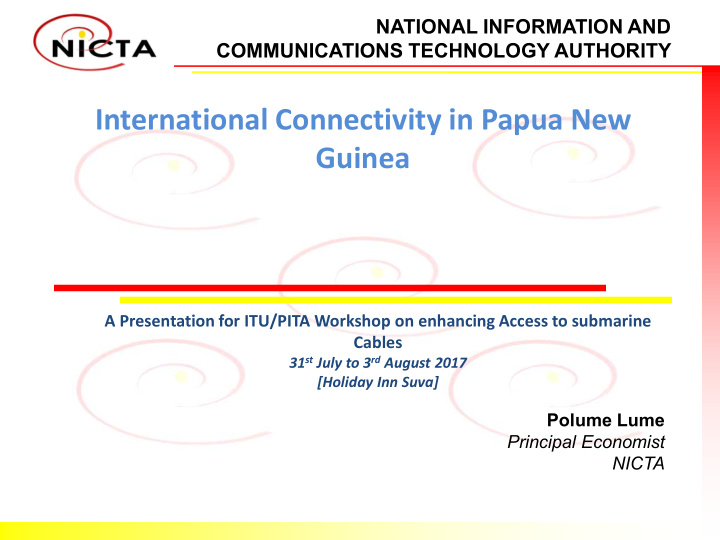



NATIONAL INFORMATION AND COMMUNICATIONS TECHNOLOGY AUTHORITY International Connectivity in Papua New Guinea A Presentation for ITU/PITA Workshop on enhancing Access to submarine Cables 31 st July to 3 rd August 2017 [Holiday Inn Suva] Polume Lume Principal Economist NICTA
NATIONAL INFORMATION AND COMMUNICATIONS TECHNOLOGY AUTHORITY Country Overview – Papua New Guinea Country Profile: Economy: Country: Papua New Guinea Main Sectors: Agriculture, Fisheries, Forestry Capital: PORT MORESBY (22 Provinces) & recently Mining & Petroleum, extractive & Territory: 470,000 KM² (600 offshores Islands) telecommunications Population: 6.1 million GDP: USD16.93 billion (overall) Region: Asia-Pacific Language: 800 Languages (2 Nat. Lan) Sector Profile: Mobile: 2.7million (3operators & Fixed line 24K Internet Exchange Point now established GDP (ICT): 8.5% Industry worth: USD350k (est) Cables: APNG2 (TPNG&Telstra) & PPC-1 (Pipe Network) Capacities - APNG 2 – 1Gbp/s&PPC-1-10Gbp s 2
NATIONAL INFORMATION AND COMMUNICATIONS TECHNOLOGY AUTHORITY Telecommunications in PNG • The PNG telecommunications network comprises of microwave radio, satellite (domestic & international) and optical fibre transmission systems (intra-city and international). • The network is 100% automatic, with international links to over 160 countries in the world and domestic services to all urban centres and major villages. Two submarine cables PPC1 & APNG2 as well as Satellite • Operators are continuously upgrading their network such as converting its telephone exchanges from analogue to digital. • Other plans are to digitize the radio bearer systems primarily to allow greater traffic flow. Alternate routing facilities for the domestic satellite system and improvements in upgrading the transmission technology • Mobile operators are currently rolling out 4G in main centers and in the process of extending to other outer parts of the country Service Providers • 30 Licensed • 3 (Digicel, and only 9 Bmobile/Vod fully afone & operational Telikom PNG LImited Mobile ISPs Operators Broadcast Fixed Line • 4 FM Radio • 1 Telikom • 17 TV PNG operators Limited Apart from the above the PNG has a National Transmission Provider for both 3 international & domestic transmission needs
NATIONAL INFORMATION AND COMMUNICATIONS TECHNOLOGY AUTHORITY Policy and Regulatory Administration The Regulator Policy & Regulations Minister Communications Department Regulator-NICTA 4
NATIONAL INFORMATION AND COMMUNICATIONS TECHNOLOGY AUTHORITY POLICY & REGULATION -UNDER SEA CABLE POLICY CONTEXT REGULATION NEGOTIATE & ABITRATE Out of the 7 Key Objectives , 5 policy objectives provides for the current regulatory framework for NICTA which includes - LICENSING, ECONOMIC & TECHNICAL REGULATION, CONSUMER PROTECTION EX ANTE ACCESS REGULATION To enjoy To substantially WHOLESALE BASED REGULATION To secure effective and increase access social & sustainable to ICT services Improve economic Efficient ICT competition across PNG with International benefits of Infrastructure to deliver service to be Connectivity an efficient market available at DECLARED SERVICES ICT Sector discipline and affordable economic prices benefits LANDING STATION LICENSED UNDER GATEWAY 5
NATIONAL INFORMATION AND COMMUNICATIONS TECHNOLOGY AUTHORITY CURRENT PNG CABLE NETWORK Source: DataCo (9 th APT Policy & 6 Regulatory Forum- PNG)
NATIONAL INFORMATION AND COMMUNICATIONS TECHNOLOGY AUTHORITY PLANNED CABLE NETWORK 7 Source: DataCo (9 th APT Policy & Regulatory Forum- PNG)
NATIONAL INFORMATION AND COMMUNICATIONS TECHNOLOGY AUTHORITY OTHER PLAN 8
NATIONAL INFORMATION AND COMMUNICATIONS TECHNOLOGY AUTHORITY SOME OF THE RISKS/CHALLENGES • Political risk – the new government may shelve the current planned projects • Domestic landing stations for national transits (Land related issues) • Traffic profiling to better understand the sources of upstream IP providers to assist in selected options. • Denial of access 9
Recommend
More recommend